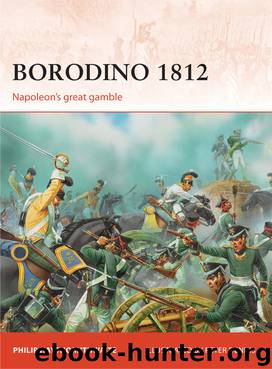Borodino 1812 by Philip Haythornthwaite

Author:Philip Haythornthwaite
Language: eng
Format: epub
Tags: Borodino 1812: Napoleon’s Great Gamble
ISBN: 9781780968810
Publisher: Osprey Publishing
The strongest part of Kutuzov’s line was his right, his concentration on that flank suggesting that he expected Napoleon’s main drive to be along the New Smolensk Road, while the left, despite the bolstering of earthworks, was weak; Clausewitz commented that, ‘The best side of the position… the right wing, could be of no avail to redeem the defects of the left’, and that the extreme strength of the right represented ‘a useless squandering of troops’. He also thought that the Russian disposition was too narrow from front to rear, that the reserves were too close to the firing-line, and attributed this, after discussions with that officer, to Toll’s influence. The cavalry, he stated, was posted only 300 to 400 paces behind the front line, and the main reserve scarcely 1,000 paces further back, so that they suffered from enemy fire even while in reserve. Clausewitz believed that had they been posted further back they could have been concealed more easily and have been used with greater freedom to move to the flanks. He also observed that the Russian artillery took up more space than that of any other army due to the number of small ammunition carts that it used, so that with the number of guns involved, and the proximity of reserves, the area behind the firing-line was ‘filled and crammed up’.
The Russian command structure included an additional tier between corps and army commanders: on the right, General Mikhail Miloradovich had jurisdiction over the corps of Baggovut and Ostermann-Tolstoy, and the cavalry of Uvarov and Korff; Raevski’s and Borozdin’s corps, and Sievers’s cavalry, came under the authority of Prince Andrei Gorchakov; Dokhturov had authority over his own corps and Kreutz’s cavalry, and Grand Duke Constantine led the whole reserve.
There are various estimates of the strength of the Russian army at the commencement of the battle, but the approximate strength seems to have been about 72,000 infantry, 17,500 cavalry, and 7,000 Cossacks; about 14,300 artillery (including five engineer companies) in 55 batteries with a total of 640 pieces of artillery; and 10,000 opolchenie. (Sir Robert Wilson’s estimate of ‘effective regulars’ was 90,000, which may include a deduction for troops detached to rear areas.)
Download
This site does not store any files on its server. We only index and link to content provided by other sites. Please contact the content providers to delete copyright contents if any and email us, we'll remove relevant links or contents immediately.
| Africa | Americas |
| Arctic & Antarctica | Asia |
| Australia & Oceania | Europe |
| Middle East | Russia |
| United States | World |
| Ancient Civilizations | Military |
| Historical Study & Educational Resources |
Life of Elizabeth I by Alison Weir(2026)
The Invisible Wall by Harry Bernstein(1764)
Art of Betrayal by Gordon Corera(1400)
1916 in 1966 by Mary E. Daly(1229)
Thunderstruck by Erik Larson(1181)
The Decline and Fall of the British Empire, 1781-1997 by Piers Brendon(1096)
A Brief History of Britain, 1066-1485 by Nicholas Vincent(1009)
A Brief History of Britain, 1485-1660 by Ronald Hutton(978)
Guy Burgess by Stewart Purvis(971)
Mary, Queen of Scots by Weir Alison(961)
Henry VIII by Alison Weir(909)
The Last Lion 02 - Winston Churchill - Alone, 1932-1940 by William Manchester(907)
Lang Lang by Lang Lang(833)
1066 by Andrew Bridgeford(829)
The Last Plantagenet by Thomas B Costain(810)
Gimson's Kings and Queens by Andrew Gimson(810)
Coalition by David Laws(806)
London: A Biography by Peter Ackroyd(803)
Diana by Andrew Morton(785)
